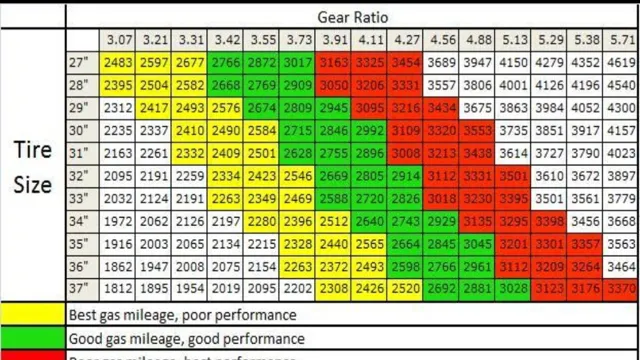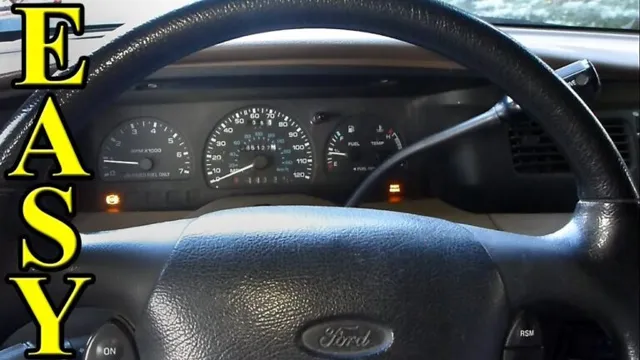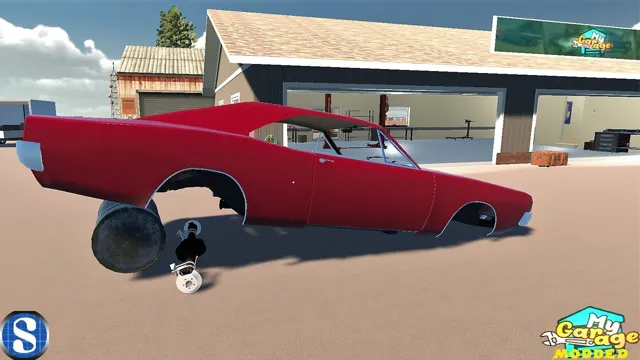Ultimate Guide: How to improve your truck’s performance with a Gear Ratio Change
Changing gear ratios on your truck can seem like a daunting task, especially for those who have never done it before. But did you know that doing so can actually improve your truck’s performance and fuel efficiency? It’s true! By adjusting the gear ratio, you can optimize the power of your engine and achieve greater control over your vehicle. Think of it like changing the gear on a bicycle.
When you switch to a lower gear, you can pedal faster and generate more torque, making it easier to climb steep hills. Conversely, when you switch to a higher gear, you can coast at higher speeds with less effort. The same concept applies to your truck’s gear ratio.
By adjusting the ratio, you can optimize your engine’s power output to better suit your driving needs. But how do you know which gear ratio is right for you? Factors like tire size, engine power, and intended use all play into the equation. That’s why it’s important to consult with a professional mechanic or do thorough research before making any changes.
With the right gear ratio, you can transform your truck into a more efficient and powerful machine. So why not give it a try and see the results for yourself?
Understanding Gear Ratios
Changing the gear ratio on your truck is an excellent way to adjust its overall performance. However, before you go ahead to change the gear ratio, it is essential to understand what gear ratios are and how they work. Gear ratios refer to the ratio between a truck’s driveshaft and the axle.
Changing the gear ratio involves swapping out the stock gears and installing new ones of a different size. A lower gear ratio offers better low-end acceleration and towing power, while a higher gear ratio is suitable for higher top-end speed. To change the gear ratio on your truck, you need to research and find out what ratio suits your specific needs.
This decision will depend on the type of driving you plan to do, such as off-road, towing, or daily driving, and the kind of tires you have. Once you have your new gear ratio, you can hire a professional mechanic to install them or use the appropriate tools to install them yourself. By changing your gear ratio, you will get better performance and more efficiency from your truck.
What Is Gear Ratio?
Gear ratio refers to the ratio of the speed of the driving gear to the speed of the driven gear in a mechanical system. It is a critical aspect of engineering and is essential in determining how much force and torque a machine can generate. Understanding gear ratios can be confusing, but it’s vital to understand how the gears work together.
The gear ratio impacts the speed and performance of machinery, including cars, bikes, and other mechanical devices. Choosing the right gear ratio is crucial to optimizing the performance of your machinery. An excellent analogy to understand gear ratio is that it’s like gears in a bicycle: if you wish to go uphill, you would switch to a lower gear, which will help you overcome the incline with less effort.
As a result, understanding gear ratios can help you optimize your machinery’s performance, making it more efficient and effective.

How Does Gear Ratio Affect Your Truck?
When it comes to your truck’s performance, understanding gear ratios is essential. Gear ratio refers to the number of teeth on the ring and pinion gears in the axle. The ratio is represented by a number, for example,
73, which means the driveshaft turns 73 times for each revolution of the wheels. A low gear ratio (higher number) provides more torque to the wheels, making it easier to start moving heavy loads or climb steep hills.
On the other hand, a high gear ratio (lower number) provides better fuel efficiency at higher speeds. It’s important to choose the right gear ratio for your truck’s purpose, whether it be off-roading or highway driving. Additionally, changing your gear ratio can affect other aspects of your truck’s performance, such as top speed and horsepower.
It’s best to consult with a professional mechanic or do extensive research before making any gear ratio changes to ensure optimal performance and longevity of your truck.
Evaluation Your Current Gear Ratio
If you’re looking to change gear ratio on your truck, it’s important to evaluate your current setup first. Your gear ratio determines the speed of your truck and can also affect fuel efficiency. To determine your gear ratio, you’ll need to count the number of teeth on your ring and pinion gears.
The ring gear is the larger gear that attaches to the differential, while the pinion gear is the smaller one that connects to the driveshaft. Divide the number of teeth on the ring gear by the number of teeth on the pinion gear to get your ratio. An easy way to change gear ratio is by swapping out your ring and pinion gears, but this can be a complex task that requires specialized knowledge and tools.
It’s important to weigh the benefits and drawbacks of changing your gear ratio and consult with a professional before making any modifications to your truck.
Identifying Your Current Gear Ratio
When it comes to evaluating your current gear ratio, it’s important to understand what it means and how it affects your cycling performance. In simple terms, your gear ratio refers to the combination of gears on your bike that determines how much effort you need to exert to make the wheels turn. However, calculating your gear ratio involves a bit of math.
You need to divide the number of teeth on your front chainring by the number of teeth on your rear cog to get your gear ratio. For example, if your chainring has 40 teeth and your cog has 16 teeth, your gear ratio is 5:
Knowing your gear ratio can help you determine if you need to make any adjustments to your bike’s gearing to improve your riding experience.
How to Know When It’s Time to Change Gears?
Knowing when to change gears can be a tricky task, but it’s essential if you want your ride to be smooth and efficient. One way to evaluate whether or not it’s time to change gears is by looking at your current gear ratio. Your gear ratio is the ratio of the number of teeth on the chainring to the number of teeth on the rear cog.
A lower gear ratio means more torque but less speed, while a higher ratio means less torque but more speed. If you find your current gear too hard to pedal on an incline, it’s a sign that you need to switch to an easier gear ratio. On the other hand, if you find yourself spinning too fast without gaining enough speed, it may be time to shift to a harder gear ratio.
Remember, getting the right gear ratio is all about finding the sweet spot between torque and speed so that you can pedal comfortably without overstressing your legs.
Selecting the Right Gear Ratio
If you’re wondering how to change gear ratio on your truck, there are a few things you need to consider. First, determine your primary use for the vehicle. Are you using it for towing, off-roading, or just everyday driving? Once you’ve identified your needs, you can begin selecting the right gear ratio.
A lower gear ratio will give you better acceleration and towing power, while a higher gear ratio will provide more top-speed and fuel efficiency. It’s important to note that changing your gear ratio can have a significant impact on your vehicle’s performance and fuel economy. That’s why it’s recommended to consult with a professional mechanic or specialist before making any changes.
They can help you choose the right gear ratio for your specific make and model, and ensure that the installation is done correctly. In summary, changing your gear ratio can have a big impact on your truck’s performance. Make sure to identify your primary usage and consult a professional before making any changes.
With the right gear ratio, you can optimize your truck’s potential and enjoy the benefits of improved acceleration, towing power, fuel efficiency, and top-speed.
Using a Gear Ratio Calculator
When it comes to selecting the right gear ratio, a gear ratio calculator can be a helpful tool. This tool allows you to input information such as tire size, transmission gear ratio, and desired RPM to calculate the best gear ratio for your needs. By selecting the right gear ratio, you can optimize your vehicle’s performance and efficiency.
A higher gear ratio provides more power and acceleration, but lower top speeds, while a lower gear ratio offers higher top speeds and better fuel efficiency. It’s important to consider the intended use of your vehicle and the terrain you’ll be driving on when selecting the right gear ratio. Using a gear ratio calculator can take the guesswork out of it and ensure that you make an informed decision.
So, if you’re looking to upgrade your vehicle’s gear ratio or simply want to optimize its performance, give a gear ratio calculator a try and see how it can benefit you.
Choosing the Right Gear Ratio for Your Needs
Choosing the right gear ratio could be a daunting task, especially for beginners. While many factors play a role in selecting the gear ratio, the ultimate decision boils down to your specific requirements. The gear ratio determines the revolutions of your wheels concerning the engine rotation.
In simpler terms, it specifies how much power gets transmitted from the engine to the wheels. If you’re looking for quicker acceleration, a lower gear ratio will do the job. Conversely, if you want fuel economy, a higher gear ratio suits you best.
Other factors that might affect your decision include the terrain you drive on, the weight of your vehicle, and your driving style. Always consider all the factors before settling on the gear ratio to ensure that you get the best performance out of your car.
Changing Your Truck’s Gear Ratio
If you’re looking to change the gear ratio on your truck, there are a few things you need to know. First, changing the gear ratio can have a significant impact on your vehicle’s performance. The gear ratio determines the speed at which your wheels turn in relation to the engine’s rotation speed.
A higher gear ratio means your vehicle can run at higher speeds, but it will have less pulling power. On the other hand, a lower gear ratio provides more pulling power but reduces your truck’s top speed. To change the gear ratio on your truck, you will need to switch out the ring and pinion gears.
This will require a good bit of technical expertise, and it’s not a job for novice mechanics. You’ll also need to have the right tools and equipment on hand. While it can be a daunting task, changing the gear ratio can be an excellent way to improve your truck’s performance.
Just be sure to approach the job with caution and attention to detail.
Replacing the Ring and Pinion Gears
Replacing the Ring and Pinion Gears in your truck can change its gear ratio. This is a process that requires some technical know-how and should be done by a professional. Changing the ratio of the gears can impact your truck’s performance, affecting acceleration, towing capacity, and fuel economy.
In some cases, a higher gear ratio can increase towing capacity but also decrease acceleration, while a lower gear ratio can increase acceleration but lower towing capacity. It’s essential to know what you’re looking to achieve before swapping the gears. Upgrading to a performance gear ratio can improve the overall performance of your truck, allowing for quicker launches and better off-roading experiences.
However, there are potential drawbacks to consider. Swapping the gears can put additional strain on your vehicle’s drivetrain, potentially causing premature wear and tear. It’s crucial to weigh the pros and cons of a gear swap and consult with a professional before making any changes.
Adjusting the Differential Carrier
One of the most effective ways to change your truck’s overall performance is by adjusting its differential carrier. This process involves changing the gear ratio, which can have a significant impact on how your truck handles different driving conditions. Essentially, the gear ratio determines how many rotations the driveshaft makes compared to the axle’s rotations.
A lower gear ratio is perfect for off-road driving, providing excellent torque and power to the wheels. On the other hand, a higher gear ratio is better suited for highway driving, as it improves fuel efficiency and reduces engine strain at high speeds. When adjusting the differential carrier, it’s crucial to choose the right gear ratio for your specific needs.
Consulting with a professional mechanic or tuner is recommended to ensure the best results for your truck. Overall, adjusting the differential carrier is a great way to fine-tune your truck’s performance and make it more suitable for your driving needs.
Re-assembling the Axle Shaft and Bearings
If you’re looking to change your truck’s gear ratio, re-assembling the axle shaft and bearings is a crucial step in the process. Once you’ve selected the new gears you want to install, you’ll need to remove the old ones and put the new ones in their place. Before doing so, however, you’ll need to re-assemble the axle shaft and bearings to make sure everything runs smoothly.
This involves cleaning the axle shaft and inspecting the bearings to ensure they’re in good working condition. Once you’ve determined that everything is in order, you can re-install the axle shaft and bearings and move on to the next step in the process. It’s important to take your time and be careful during this step, as any mistakes could cause serious damage down the line.
By following the proper procedures, however, you can successfully change your truck’s gear ratio and enjoy improved performance on the road.
Testing Your New Gear Ratio
Changing your truck’s gear ratio can significantly improve its performance, whether you’re looking for more speed or better fuel efficiency. But how do you know if the new gear ratio is working as it should? The best way to test your new gear ratio is by taking your truck for a spin and monitoring how it performs. Look for changes in acceleration, top speed, and fuel economy.
You should also pay attention to any unusual sounds or vibrations. It’s important to note that changing your gear ratio can affect other parts of your truck, such as the transmission and drivetrain, so it’s a good idea to get a professional opinion if you experience any issues. With some testing, you’ll be able to accurately gauge the effectiveness of your new gear ratio and enjoy the benefits it brings to your truck’s performance.
Identifying the Signs of a Poor Gear Ratio
When it comes to testing a new gear ratio, there are a few signs to look out for to make sure everything is running smoothly. One of the first signs to be aware of is a lack of power or acceleration. This can happen because the gear ratio isn’t allowing for enough torque to be transferred from the engine to the wheels.
Another sign of a poor gear ratio is excessive noise coming from the transmission. This can be a result of gear teeth not engaging properly due to an incorrect ratio. It’s important to also pay attention to the RPMs and fuel efficiency.
If the RPMs are too high or the fuel efficiency decreases significantly, there may be an issue with the gear ratio. Testing a new gear ratio is crucial for ensuring the performance and longevity of your vehicle.
Taking Your Truck for a Test Drive
When it comes to upgrading your truck’s gear ratio, taking it for a test drive is crucial. You may have done all the research, read up on reviews, and gathered advice from experts, but only when you feel it firsthand can you truly know if it’s the right fit for your vehicle. One thing to keep in mind when testing your new gear ratio is to be patient and take it slow at first.
Gradually ease into different speeds to get a feel for how the truck is responding, as well as any potential vibrations or noises. It’s also a good idea to pay attention to how the truck handles on hills or while towing, as this can be a key indicator of whether the new gear ratio is effective or not. Overall, the goal of a test drive is to determine if the upgrade is worth the investment and to ensure that your truck is performing at its optimal level.
Conclusion
When it comes to changing gear ratios on your truck, it’s important to remember that this isn’t a job for the faint of heart. It requires some serious mechanical know-how, patience, and a willingness to get your hands dirty. But if you’re up for the challenge, the benefits can be tremendous – increased torque, improved acceleration, and better fuel efficiency.
So if you’re ready to take the plunge and change your truck’s gear ratio, remember to do your research, invest in quality parts, and don’t be afraid to ask for help when you need it. With a little elbow grease and a lot of hard work, you’ll be cruising down the highway in no time – and who knows, you might even impress a few gearheads along the way.”
FAQs
What is gear ratio in a truck?
Gear ratio is a measurement of the number of revolutions the driveshaft makes in relation to the number of revolutions the wheels make.
Why would you want to change the gear ratio on a truck?
There are several reasons to change the gear ratio, including increasing towing power, improving fuel economy, or achieving higher speeds.
Can you change the gear ratio yourself?
It is possible to change the gear ratio yourself, but it is a complex process and requires specialized knowledge and tools.
How much does it cost to change the gear ratio on a truck?
The cost of changing the gear ratio varies depending on the make and model of the truck and the desired outcome. It can range from a few hundred to several thousand dollars.
How do you determine the best gear ratio for your truck?
The ideal gear ratio depends on the intended use of the truck. A lower gear ratio provides more torque for towing or off-roading, while a higher gear ratio can improve fuel economy. Consulting with a mechanic or automotive specialist can help determine the best gear ratio for your specific needs.







